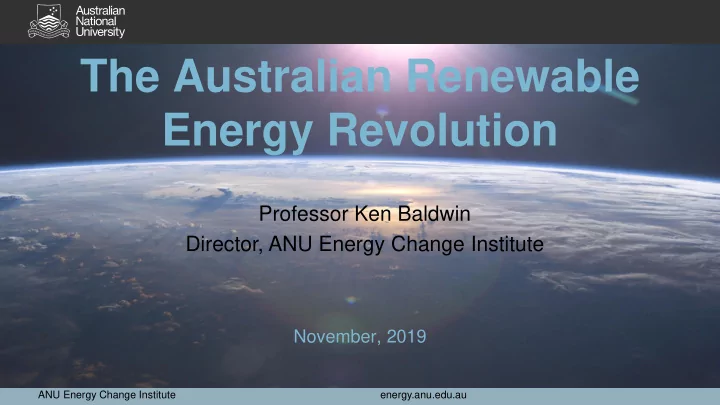

The Australian Renewable Energy Revolution Professor Ken Baldwin Director, ANU Energy Change Institute November, 2019 ANU Energy Change Institute energy.anu.edu.au 1 ANU Energy Change Institute energy.anu.edu.au
ANU Energy Change Institute A wide spectrum of Energy research: Technology and Policy neutral Technologies: Human Sciences: • • Artificial Photosynthesis Energy Economics and Policy • • Energy Storage and Recovery Energy Efficiency • • Enhanced Oil and Gas/ CCS Energy and Security • • Fusion Power Energy for Development • • Nuclear Science Energy-Water Nexus • • Renewable Fuels Energy Regulation and Governance • • Smart Grid Energy Sociology and Risk • • Solar PV Hydrogen Economy • • Solar Thermal Sustainable Transport • Wind Energy >$100M in facilities and >300 researchers ANU Energy Change Institute energy.anu.edu.au 2 ANU Energy Change Institute energy.anu.edu.au
3 The climate change imperative Australia’s Paris 539 } commitment: 98 • 26 – 28% reduction by 2030 in GHG emissions based on 2005 levels ANU Energy Change Institute energy.anu.edu.au 3
4 Australia’s GHG emissions IF the electricity sector provides the best opportunity to RE make the most rapid impact, then this requires >>28% RE GHG emissions RE reductions by 2030 RE RE given that the other sectors are harder to address. ANU Energy Change Institute energy.anu.edu.au 4
5 Australia is moving in the wrong direction ….. ANU Energy Change Institute energy.anu.edu.au 5
6 ….even though our per capita/per GDP isn’t ANU Energy Change Institute energy.anu.edu.au 6
7 Agriculture emissions are constant ANU Energy Change Institute energy.anu.edu.au 7
8 Australia is an energy powerhouse Australia has an abundance of energy of all types (except oil) ANU Energy Change Institute energy.anu.edu.au 8
Australia as a RE powerhouse Electricity for all of Australia and the world ANU Energy Change Institute energy.anu.edu.au 9
10 Renewable Energy Pipeline Source: Clean Energy Regulator } Large-scale renewable energy capacity installation rate: currently ~ 4.0 GW p.a. ~6.4 GW p.a. Small-scale renewable energy capacity installation rate: currently ~ 2.4 GW p.a. ANU Energy Change Institute energy.anu.edu.au 10
11 Australia is a RE powerhouse Australia leads the world with 250W per capita p.a. wind and solar installation rate, and the highest penetration of rooftop solar (24%) Source: the International Renewable Energy Agency ANU Energy Change Institute energy.anu.edu.au 11
Renewable / fossil replacement rate ANU Energy Change Institute energy.anu.edu.au 12 ANU Energy Change Institute energy.anu.edu.au 12
Projections if industry installation continues If industry is allowed to continue installing renewables at the current rate then Australia will: • Reach the 2020 Renewable Energy Target in 2019 - Sept. ! (and probably the old pre-Abbott RET in 2020) • Reduce electricity sector emissions by 26% by 2021* • Attain our 26% Paris goals for the entire economy by 2025 • Reach 50% renewable electricity by 2024 • Approach 100% renewable electricity in the early 2030’s * Assuming GHG emissions and electricity demand remain constant ANU Energy Change Institute energy.anu.edu.au 13 ANU Energy Change Institute energy.anu.edu.au 13
Energy growth shifts to Asia Source: International Energy Agency World Energy Outlook 2013 Primary energy demand, 2035 (Mtoe) Share of global growth 2012-2035 Eurasia OECD Eurasia Latin Europe America 5% 4% 1 370 8% 1 710 China Africa 8% Japan United 4 060 2 240 440 States Middle 1 050 Middle 10% East East 1 000 Southeast 65% Brazil 1 540 Asia 1 030 480 India Africa Non-OECD Asia China is the main driver of increasing energy demand in the current decade, but India takes over in the 2020s as the principal source of growth ANU Energy Change Institute energy.anu.edu.au 14
Australia’s current (carbon -based) energy trade ECI’s $10m ANU Grand Challenge: To future-proof Australia’s energy exports – based on Renewable Energy ANU Energy Change Institute energy.anu.edu.au 15 ANU Energy Change Institute energy.anu.edu.au
ANU $10m Grand Challenge Zero-Carbon Energy for the Asia-Pacific 20x domestic 260 TWh/y !! ANU Energy Change Institute energy.anu.edu.au 16
ANU Thank you! Energy Change Institute ANU Energy Change Institute energy.anu.edu.au 17 ANU Energy Change Institute energy.anu.edu.au
Technology learning rate: solar PV 1/100th price per Compound annual module! growth rate (CAGR) of 33% for the last 30+ years! Time Source: Fraunhofer Institute 2018 PV Report ANU Energy Change Institute energy.anu.edu.au 18 ANU Energy Change Institute energy.anu.edu.au
Technology learning rate: wind Source: energytransition.org Currently 5 MW - 100x capacity ANU Energy Change Institute energy.anu.edu.au 19 ANU Energy Change Institute energy.anu.edu.au
Electricity demand and sources carbon tax removed Source: Pitt and Sherry, October 2016 ANU Energy Change Institute energy.anu.edu.au 20
How high can renewables go? • The higher the penetration (>50 %), the Adds 50% higher the cost to cover intermittency: to LCOE • Overbuild supply } but still • Build additional storage capability cheaper • Build additional network infrastructure than coal • Will this provide the same level of reliability Yes – perhaps better of supply? • Will this provide the same level of security e.g. increasing extreme weather events? Maybe ANU Energy Change Institute energy.anu.edu.au 21 ANU Energy Change Institute energy.anu.edu.au
World-wide trends in energy • Rapid decarbonisation of the energy sector – solar, wind, hydro, nuclear (fusion?) • Increasing availability of domestic energy sources results in greater energy security • More disseminated generation, storage and demand response (the ‘internet’ of energy) • Increased vulnerability to cyber threats ANU Energy Change Institute energy.anu.edu.au 22
23 Elephants in the room Australia needs to: • address continuing government policy uncertainty (which threatens and inflates new investment) by: ➢ placing an economy-wide price on carbon ➢ creating market incentives for more transmission and storage • put all options on the table - including nuclear • educate NIMBYism – community acceptance • address the threat to the electricity grid model and the accompanying social equity issues ANU Energy Change Institute energy.anu.edu.au 23
Energy generation sources Fossil Nuclear Global Solar Fission Direct Indirect Fusion Solar heat Wind Oil Photovoltaics Hydro Gas Tidal Wave Thermal electric Coal Thermochemical Biomass Geothermal ANU Energy Change Institute energy.anu.edu.au 24 ANU Energy Change Institute energy.anu.edu.au
Recommend
More recommend